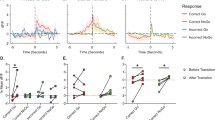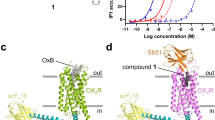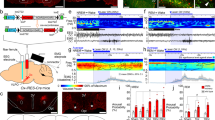Abstract
The hypothalamic peptides named the orexins, or hypocretins, were discovered in 1998. In 1999 it was established that genetic narcolepsy could be caused by mutations in the genes synthesizing these peptides or their receptors. In September of 2000 it was found that most human narcolepsy is caused by loss of hypocretin cells, most likely as a result of a degenerative process. This paper reviews these events and their implications for our understanding of brain arousal and motor control systems.
Similar content being viewed by others
Log in or create a free account to read this content
Gain free access to this article, as well as selected content from this journal and more on nature.com
or
References
Aston-Jones G, Bloom FE . (1981): Activity of norepinephrine-containing locus coeruleus neurons in behaving rats anticipates fluctuations in the sleep-waking cycle. J Neurosci. 1: 876–886
Baker TL, Dement WC . (1985): Canine narcolepsy-cataplexy syndrome: Evidence for an inherited monoaminergic-cholinergic imbalance. In McGinty DJ, Drucker-Colin R, Morrison A, Parmeggiani PL (eds), Brain Mechanisms of Sleep. New York, Raven Press, pp 199–234
Buchsbaum MS, Mendelson WB, Duncan WC, Coppola R, Kelsoe J, Gillin JC . (1982): Topographic cortical mapping of EEG sleep stages during daytime naps in normal subjects. Sleep 5: 248–255
Chemelli RM, Willie JT, Sinton C, Elmquist J, Scammell T, Lee C, Richardson J, Williams S, Xiong Y, Kisanuki Y, Fitch T, Nakazato M, Hammer R, Saper C, Yanagisawa M . (1999): Narcolepsy in orexin knockout mice: Molecular genetics of sleep regulation. Cell 98: 437–451
Chemelli RM, Sinton CM, Yanagisawa M . (2000): Polysomnographic characterization of orexin-2 receptor knockout mice. Sleep 23: A296–A297
De Lecea L, Kilduff T, Peyron C, Gao XB, Foye PE, Danielson PE, Fukahara C, Battenberg ELF, Gautvik VT, Barlett FS, Frankel WN, van den Pol AN, Bloom F, Gautvik KM, Sutcliffe JG . (1998): The hypocretins: Hypothalamus-specific peptides with neuroexcitatory activity. Proc Natl Acad Sci USA 95: 322–327
Foote SL, Bloom FE, Aston-Jones G . (1983): Nucleus locus ceruleus: New evidence of anatomical and physiological specificity. Physiol Rev 63: 844–914
Fredrick GC, Quinn CP, Gillin JG, Wyatt RJ . (1977): Deprivation of rapid eye movement sleep and nesting behavior in rats. Physiology and Behavior 18: 341–344
Gillin JC, Horwitz D, Wyatt RJ . (1976): Pharmacologic studies of narcolepsy involving serotonin, acetylcholine, and monoamine oxidase. In Guilleminault C, Dement WC, Passouant P (eds), Narcolepsy. New York, Spectrum Publications, Inc., pp585–604
Gillin JC, Mendelson WB, Sitaram N, Wyatt RJ . (1978): The neuropharmacology of sleep and wakefulness. Ann Rev Pharmacol Toxicol 18: 563–579
Gillin JC, Sitaram N, Duncan WC . (1979): Muscarinic supersensitivity: A possible model for the sleep disturbance of primary depression? Psych Res 1: 17–22
Gillin JC, Van Kammen DP, Post RM, Sitaram N, Wyatt RJ, Bunney J . (1981): What is the role of dopamine in the regulation of sleep-wake activity? In Corsini GU, Gessa GL (eds), Clinical Pharmacology. New York, Raven Press, pp 157–164
Guilleminault C, Anognos A . (2000): Narcolepsy. In Kryger MH, Roth T, Dement WC (eds), Principles and Practice of Sleep Medicine. Philadelphia, W.B. Saunders, pp 676–686
Harrison TA, Chen CT, Dun NJ, Chang JK . (1999): Hypothalamic orexin A-immunoreactive neurons project to the rat dorsal medulla. Neurosci Lett 273: 17–20
Hublin C, Kaprio J, Partinen M, Koskenvuo M, Heikkila K, Koskimies S, Guilleminault C . (1994): The prevalence of narcolepsy: an epidemiological study of the Finnish twin cohort. Ann Neurol. 35: 709–716
Ichinose M, Asai M, Sawada M, Sasaki K, Oomura Y . (1998): Induction of outward current by orexin-B in mouse peritoneal macrophages. FEBS Lett 440: 51–54
John J, Wu MF, Siegel JM . (2000a): Hypocretin-1 reduces cataplexy and normalizes sleep and waking durations in narcoleptic dogs. Sleep 23: A12
John J, Wu M, Siegel J . (2000b): Systemic administration of hypocretin-1 reduces cataplexy and normalizes sleep and waking durations in narcoleptic dogs. Sleep Res Online 3: 23–28 http://www.sro.org/2000/John/23/.
Jouvet M . (1962): Recherches sur les structures nerveuses et les mechanismes responsables des differentes phases du sommeil physiologique. Arch Ital Biol 100: 125–206.
Kastin AJ, Akerstrom V . (1999): Orexin A but not orexin B rapidly enters brain from blood by simple diffusion. J Pharmacol Exp Ther 289: 219–223
Kennedy C, Gillin JC, Mendelson W, Suda S, Miyaoka M, Ito M, Nakamura RK, Storch FI . (1982): Local cerebral glucose utilization in non-rapid eye movement sleep. Nature 297: 325–327
Kiyashchenko LI, Mileykovskiy BY, Lai YY, Siegel JM . (2001): Increased and decreased muscle tone with orexin (hypocretin) microinjections in the locus coeruleus and pontine inhibitory area. J Neurophysiol. 85: 2008–2016
Lai YY, Siegel JM . (1991): Ponto-medullary glutamate receptors mediating locomotion and muscle tone suppression. J Neurosci 11: 2931–2937
Lin L, Faraco J, Kadotani H, Rogers W, Lin X, Qui X, de Jong P, Nishino S, Mignot E . (1999): The REM sleep disorder canine narcolepsy is caused by a mutation in the hypocretin (orexin) receptor gene. Cell 98: 365–376
Methippara MM, Alam MN, Szymusiak R, McGinty D . (2000): Effects of lateral preoptic area application of orexin-A on sleep-wakefulness. Neuroreport 11: 3423–3426
Mitler MM, Dement WC . (1977): Sleep studies on canine narcolepsy: pattern and cycle comparisons between affected and normal dogs. Electroenceph Clin Neurophysiol 43: 691–699
Nishino S . (2000): Clinical and etiological aspects of canine narcolepsy. Retreat on Narcolepsy And Hypocretins (Orexins) August 14–15, 2000 Westin Hapuna Beach Prince Hotel.
Nishino S, Ripley B, Overeem S, Lammers GJ, Mignot E . (2000): Hypocretin (orexin) deficiency in human narcolepsy. The Lancet 355: 39–41
Peyron C, Faraco J, Rogers W, Ripley B, Overeem S, Charnay Y, Nevsimalova S, Aldrich M, Reynolds D, Albin R, Li R, Hungs M, Pedrazzoli M, Padigaru M, Kucherlapati M, Fan J, Maki R, Lammers GJ, Bouras C, Kucherlapati R, Nishino S, Mignot E . (2000): A mutation in a case of early onset narcolepsy and a generalized absence of hypocretin peptides in human narcoleptic brains. Nat Med 6: 991–997
Peyron C, Tighe DK, van den Pol AN, De Lecea L, Heller HC, Sutcliffe JG, Kilduff TS . (1998): Neurons containing hypocretin (orexin) project to multiple neuronal systems. Journal of Neuroscience 18: 9996–10015
Pompeiano O . (2000): Role of the locus coeruleus in the static and dynamic control of posture. Arch Ital de Biologie (in press).
Rasmussen K, Morilak DA, Jacobs BL . (1986): Single unit activity of locus coeruleus neurons in the freely moving cat. I. During naturalistic behaviors and in response to simple and complex stimuli. Brain Res 371: 324–334
Rechtschaffen A, Wolpert EA, Dement WC, Mitchel SA, Fisher C . (1963): Nocturnal sleep of narcoleptics. Electroenceph Clin Neurophysiol. 15: 599–609
Riehl J, Nishino S, Cederberg R, Dement WC, Mignot E . (1998): Development of cataplexy in genetically narcoleptic dobermans. Exp Neruol. 152: 292–302
Sakurai T, Amemiya A, Ishii M, Matsuzaki I, Chemelli RM, Tanaka H, Williams SC, Richardson JA, Kozlowski GP, Wilson S, Arch JR, Buckingham RE, Haynes AC, Carr SA, Annan RS, McNulty DE, Liu WS, Terrett JA, Elshourbagy NA, Bergsma DJ, Yanagisawa M . (1998): Orexins and orexin receptors: a family of hypothalamic neuropeptides and G protein-coupled receptors that regulate feeding behavior. Cell 92: 573–585
Schenkel E, Siegel JM . (1989): REM sleep without atonia after lesions of the medial medulla. Neurosci Lett. 98: 159–165
Shiromani PJ, Armstrong DM, Berkowitz A, Jeste DV, Gillin JC . (1988b): Distribution of choline acetyltransferase immunoreactive somata in the feline brainstem: implications for REM sleep generation. Sleep 11: 1–16
Shiromani PJ, Armstrong DM, Bruce G, Hersh LB, Groves PJ, Gillin C . (1987): Relation of pontine choline acetyltranferase immunoreactive neurons with cells which increase discharge during REM sleep. Brain ResBull. 18: 447–455
Shiromani PJ, Armstrong DM, Gillin JC . (1988a): Cholinergic neurons from the dorsolateral pons project to the medial pons: a WGA-HRP and choline acetyltransferase immunohistochemical study. Neurosci Lett. 95: 19–23
Shiromani PJ, Gillin JG . (1987): Acetylcholine and the regulation of REM sleep: Basic mechanisms and clinical implications for affective illness and narcolepsy. Ann Rev Pharmacol Toxicol. 27: 137–156
Shiromani PJ, Overstreet D, Levy D, Goodrich CA, Campbell SS, Gillin JC . (1988c): Increased REM sleep in rats selectively bred for cholinergic hyperactivity. Neuropscyhopharm. 1: 127–133
Shoham S, Teitelbaum P . (1982): Subcortical waking and sleep during lateral hypothalamic “somnolence” in rats. Physiol Behav. 28: 323–333
Siegel JM . (1999): Narcolepsy: A key role for hypocretins (orexins). Cell 98: 409–412
Siegel JM, Nienhuis R, Fahringer H, Paul R, Shiromani P, Dement WC, Mignot E, Chiu C . (1991): Neuronal activity in narcolepsy: identification of cataplexy related cells in the medial medulla. Science 262: 1315–1318
Siegel JM, Nienhuis R, Gulyani S, Ouyang S, Wu MF, Mignot E, Switzer RC, Cornford M . (1999): Neuronal degeneration in canine narcolepsy. J Neurosci 19: 248–257
Sitaram N, Nurnberger JI, Gershon ES, Gillin JC . (1980): Faster cholinergic REM sleep induction in euthymic patients with primary affective illness. Science 208: 200–202
Sitaram N, Wyatt RJ, Dawson S, Gillin JC . (1976): REM sleep induction by physostigmine infusion during sleep. Science 191: 1281–1283
Sutin EL, Shiromani PJ, Kelsoe J, Storch FI, Gillin JC . (1986): Rapid-eye movement sleep and muscarinic receptor binding in rats are augmented during withdrawal from chronic scopolamine treatment. Life Sci 39: 2419–2427
Thannickal TC, Moore RY, Aldrich M, Albin R, Cornford M, Siegel JM . (2000a): Human narcolepsy is linked to reduced number, size and synaptic bouton density in hypocretin-2 labeled neurons. Abstr Soc Neurosci 26: 2061
Thannickal TC, Moore RY, Nienhuis R, Ramanathan L, Gulyani S, Aldrich M, Cornford M, Siegel JM . (2000c): Reduced number of hypocretin neurons in human narcolepsy. Neuron 27: 469–474
Thannickal TC, Nienhuis R, Ramanathan L, Gulyani S, Turner K, Chestnut B, Siegel JM . (2000b): Preservation of hypocretin neurons in genetically narcoleptic dogs. Sleep 23: A296
Trivedi P, Yu H, MacNeil DJ, Van der Ploeg LH, Guan XM . (1998): Distribution of orexin receptor mRNA in the rat brain. FEBS Lett 438: 71–75
Wu MF, Gulyani S, Yao E, Mignot E, Phan B, Siegel JM . (1999): Locus coeruleus neurons: cessation of activity during cataplexy. Neuroscience 91: 1389–1399
Wu MF, John J, Nguyen GB, Siegel JM . (2000): Serotonergic dorsal raphe rem-off cells reduce discharge but do not shut off during cataplexy. Sleep 23: A2–A3
Author information
Authors and Affiliations
Corresponding author
Additional information
Supported by the Medical Research Service of the Dept. of Veterans Affairs, NS14610, MH64109 and HL60296
Rights and permissions
About this article
Cite this article
Siegel, J., Moore, R., Thannickal, T. et al. A Brief History of Hypocretin/Orexin and Narcolepsy. Neuropsychopharmacol 25 (Suppl 1), S14–S20 (2001). https://doi.org/10.1016/S0893-133X(01)00317-7
Issue date:
DOI: https://doi.org/10.1016/S0893-133X(01)00317-7
Keywords
This article is cited by
-
Sleep Consequences of Prader-Willi Syndrome
Current Neurology and Neuroscience Reports (2023)
-
An overview of the orexinergic system in different animal species
Metabolic Brain Disease (2021)
-
Glucagon regulates orexin A secretion in humans and rodents
Diabetologia (2014)



